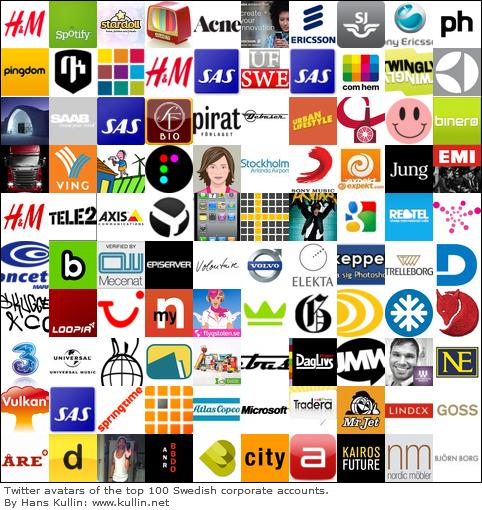In a recent post on the {grow} blog, Mark Schaefer discussed if brands should use a logo or a face as avatar on Twitter. The post “Your company’s single biggest mistake on Twitter” argues that brands would be better off by being more personal and use a photo of a person instead of a logotype. That would make it easier for followers to connect to the company on Twitter.
“If all you want to do is broadcast press releases, than go ahead and “go logo.” But if you want to create some authentic connection with your audience, I strongly recommend you put a face on the account.”
For larger companies or brands, I don’t think that’s a good idea. It might work for really small companies or for accounts that have a certain niche, like R&D or some other expert, but not for the main corporate account. Todd Defren yesterday published an email conversation about this topic that he had with his colleagues, and several of these arguments sound reasonable to me.
“I think a face is weird because it’s a company/entity not a person and as you say, people leave/change. And some logos are iconic and memorable … My son knew companies by their logos before he could read, and now he is probably a Starbucks lifer. But I might just be the oddball here.”
– Cathy“Personally I identify with logos as well. It’s brand recognition. I don’t like Comcast or Pfizer more because they have a face or several faces (which can be confusing in itself!) associated with their Twitter handle. People identify with meaningful content, messages and customer service. That’s my two cents.”
– Melanie“Agree on logos having a place. You can still be personable (and a person) within that brand. Consumers need to identify with you and the company that you represent.”
– Louise
The largest Swedish corporate accounts
I don’t believe at all that it is not possible to engage in conversation with customers if you have a logo as avatar. Let’s have a look at some of the most popular Swedish corporate accounts. The account with most followers is H&M (@hm). As much as 67% of its tweets are replies, which shows a high degree of conversation with other users. The second most followed account is Spotify (@spotify). 71% of its tweets are replies. Another example in the top ten is SJ (@sj_ab) with 91% replies.
As a comparison, both Mark Schaefer and I have a lower share of replies: 42% of our tweets are replies to others. Of course, that is no evidence that one strategy is better than the other, but I think it shows that is is possible to engage with customers on Twitter and still use a corporate logo.
The image below shows the 100 Swedish corporate Twitter accounts with most followers, from H&M (#1) to Björn Borg (#100). Only two of them have a photo of the person behind the account. A few use an image of the product (the Ice Hotel and Scania Group), but the vast majority use a logo.
Here is our list of more than 440 Swedish corporate Twitter accounts.
Footnote: Stats of %replies from Tweetstats.com

This is an extremely interesting perspective and I thank you for it.
In my original post I point to several best practices of companies using logos. However, I think the main point people miss is that the social web, and espcially Twitter, is neither B2B or B2C. It’s P2P – person to person. In my article i am trying to illustrate this point in an entertaining manner.
Also the data you provide on my reply rate are misleading because as many as 100 to 600 tweets a day might meniton my name in association with a blog post or other event that is simply content being re-tweeted. I could not possibly engage with that many people, nor would they expect me to since they are simply sharing my content. If you take that out, my reply rate would be dramatically higher.
Unlike a brand, I don;t have a paid staff fielding tweets, but if somebody engages with me directly, my response rate is probably close to 100%.
I do understand the point you are trying to make and applaud the effort but wanted to provide an additional perspective.
Thanks for carrying the torch on the conversation. Well done!
Thanks for taking the time to comment, Mark.
My main point was of course not that you (or me for that matter) should have a higher degree of replies. I don’t think it is neither possible nor desirable for a person to have such high share of tweets that are replies. These companies are using Twitter for customer service and for building relations with the community, and as you say, they have a paid staff to do so.
Regarding the analysis of yours and my Twitter stats, I may be wrong. I used Tweetstats.com and they are usually pretty accurate, but I may have gotten their methodology wrong.
I think we both think the same, regarding that the conversation on Twitter is first and foremost person to person. I just wanted to illustrate that it is possible to keep a personal tone and a lively dialogue, and still have the logo as avatar on Twitter. But as always, there is no one solution that fits everyone. What’s most important is how you actually use the account and what you make of it, not the actual branding of it, in my view.
Anyway, thanks for commenting and keep up the great work with you excellent blog.
Perhaps I should add, that the numbers in my blog post aren’t the number of “answers” to replies or mentions (they may very well be 100%). They are the percentage of all tweets from an account that are replies, as opposed to “just” tweets or retweets.